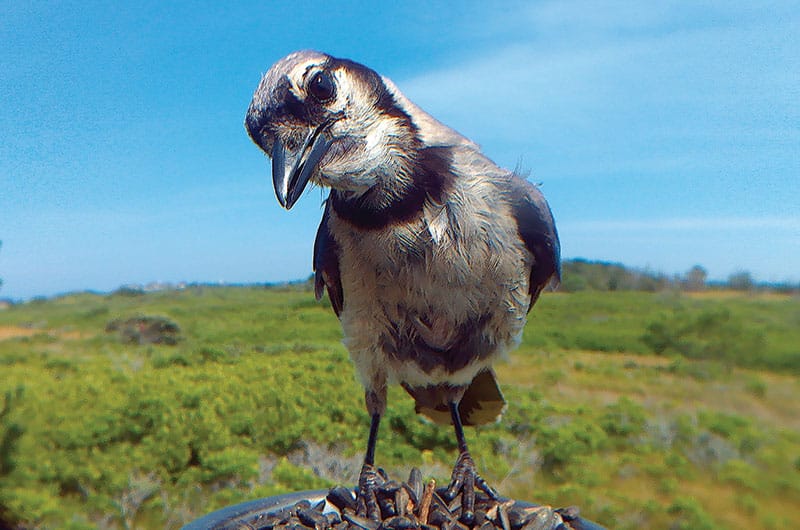by Sarah Treanor Bois Director of Research & Education for the Linda Loring Nature Foundation

Fall is also an exceptional time for birding on Nantucket. Thirty miles out to sea makes us a great stopover for migrants. Fall storms can also bring unusual birds from afar – a treasure for local birders adding to life-lists.
With fall upon us and migration underway, how can you attract more birds to your yard, feeders, and other favorite viewing spots? How can you have a good chance of seeing more birds this fall? Here are a few ideas to naturally increase your chances of seeing some great birds without having to spend thousands of dollars on new optics. Let the weeds be. As the fall flowers and grasses begin to fade, the seeds, fruits, and other reproductive structures are delectable bites for our feathered friends. Don’t be tempted to mow that lawn or weedy patch. Let it whither until winter. As many birds begin or are in the throes of migration, these weedy tidbits become important food resources. And you want any excuse to be a bit lazy, right?
Water, water, everywhere? Make sure your bird baths or other water features are clean and full. Migrants often need to fill up on water as well as food. While the weather has been rainy of late, double-check that the water that remains in baths is clean to reduce disease transmission.
Don’t rake the beach! If you’re a shorebird, fall is the perfect time to snag invertebrates from piles of seaweed washed up on the beach. Keep the eel grass and other seaweed piles intact as they remain another tasty treat for Sanderlings, Willets, and other shorebirds. Better yet, take a walk and clean the beach to remove plastic debris that may be inadvertently ingested by curious and hungry shorebirds.

Watch the weather. During fall migration, birds are moving every day. However, the volume of birds is affected by local and regional weather patterns. Wind circulation patterns around highs and lows impact the movement of migratory birds. The ideal time for flying often occurs the day after a cold front passes – northerly winds, dropping temperatures, rising air pressure, and clearing skies are good migration conditions. Look for tail winds which is when birds will move en masse. When this happens, get your binoculars ready and head out.
Get to know a few good birders. The best thing I ever did to increase my own bird list was to get to know some really good birders. They keep you motivated, take you to the best secret spots, and may teach you a thing or two about identifying all of those “confusing fall warblers” as Peterson puts it. Once fall really sets in and we get into winter, birding friends also help you forget how cold your fingertips are while trying to spot a Glaucous Gull or a Snowy Owl.
Need help meeting some great birders? How about some local and regional experts? There is a Birding Nantucket Facebook group (facebook.com/groups/birdingnantucket/) that is great for sharing photos and information about the latest sightings. Sign up for an eBird account (ebird.org/content/ebird/) through the Cornell Lab of Ornithology. You’ll be able to see others’ checklists, where the local hotspots might be, and even who is seeing them.
The Linda Loring Nature Foundation leads bird walks every Wednesday morning at 8am (llnf.org). The Maria Mitchell Association also leads walks Tuesday mornings at 7am (mariamitchell.org/calendar). As the weather gets colder, a morning bird group will start meeting on Sunday mornings at the Nantucket High School parking lot. Check the events calendar on Nantucket.net for these and other listings.


